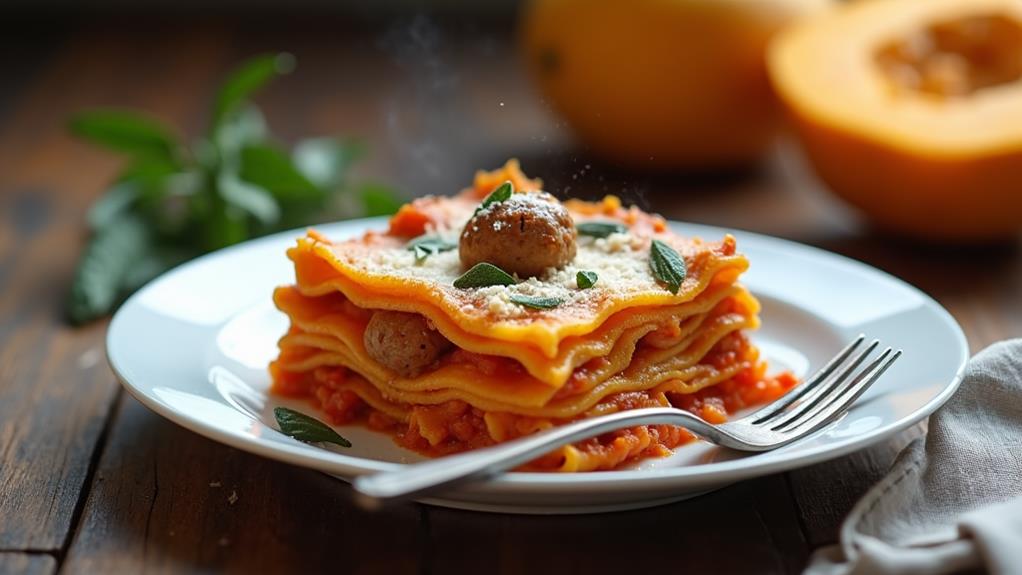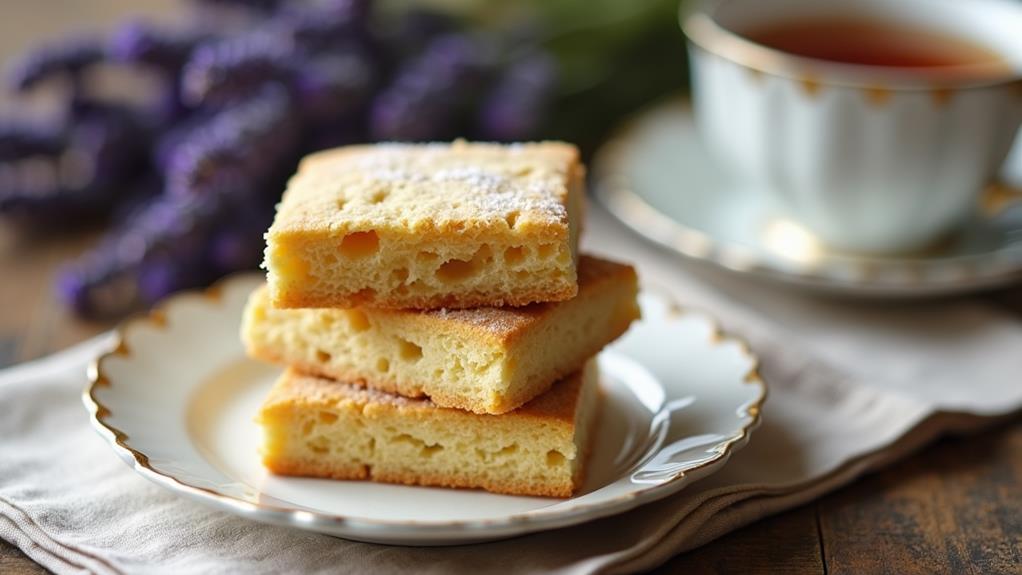As the crisp autumn leaves dance on the wind, you might find yourself craving a comforting dish that embodies the season's warmth. Meatball, Sage, and Squash Lasagna offers just that—a unique twist on a classic Italian favorite. You'll discover how this inventive recipe combines the savory richness of meatballs with the subtle sweetness of butternut squash and the earthy aroma of fresh sage. But there's more to this dish than meets the eye. Its layers of flavor and texture tell a story of culinary innovation and seasonal inspiration. What secrets lie within its golden, bubbly crust?
Key Takeaways
- Combines savory meatballs, aromatic sage, and sweet butternut squash for a unique lasagna flavor profile.
- Uses pre-made meatballs and no-boil noodles for convenience while maintaining a gourmet taste.
- Layered with marinara sauce, sliced meatballs, butternut squash puree, and fresh sage leaves.
- Baked covered for 30 minutes, then uncovered for 15 minutes to achieve a golden, bubbly top.
- Ideal for fall and winter gatherings, offering a hearty and satisfying seasonal meal.
History
Tracing its roots to traditional Italian cuisine, this meatball, sage, and squash lasagna represents a modern twist on a classic dish.
You'll find that lasagna's origins date back to ancient Rome, where it was first mentioned in cookbooks as layered pasta with sauce. Over time, it evolved into the beloved casserole we know today, with regional variations emerging across Italy.
In the 20th century, Italian immigrants brought lasagna to America, where it quickly became a staple comfort food. The addition of meatballs to lasagna is a more recent innovation, combining two favorite Italian-American dishes.
Sage, an herb long used in Italian cooking, adds a distinctive flavor that complements both the meat and the squash.
The incorporation of squash into lasagna reflects a growing trend towards seasonal, vegetable-forward cooking. You'll notice that this recipe balances traditional elements with modern tastes, creating a unique dish that honors its heritage while embracing contemporary culinary preferences.
Recipe
This unique lasagna combines the comforting flavors of classic meatballs with the earthy taste of sage and the sweetness of squash. It's a perfect dish for fall or winter, offering a hearty meal that's both satisfying and delightfully different from traditional lasagna recipes.
By limiting the ingredients to just five key components, this recipe simplifies the cooking process without sacrificing flavor. The meatballs provide a rich, savory base, while the sage adds an aromatic depth. The squash brings a touch of sweetness and a creamy texture that complements the other ingredients beautifully.
- 1 pound (450g) pre-made meatballs
- 1 package (9 oz / 255g) no-boil lasagna noodles
- 2 cups (480ml) marinara sauce
- 2 cups (480ml) butternut squash puree
- 1/4 cup (60ml) fresh sage leaves, chopped
Preheat the oven to 375°F (190°C). In a 9×13 inch (23×33 cm) baking dish, spread a thin layer of marinara sauce. Layer lasagna noodles, followed by sliced meatballs, squash puree, and chopped sage.
Repeat the layers, ending with a layer of noodles topped with the remaining marinara sauce. Cover with foil and bake for 30 minutes, then remove the foil and bake for an additional 15 minutes until the top is golden and bubbly. Let it rest for 10 minutes before serving.
For best results, use high-quality pre-made meatballs or make your own ahead of time. If using frozen meatballs, be sure to thaw them completely before assembling the lasagna.
To save time, you can use canned butternut squash puree, but fresh roasted and pureed squash will provide a richer flavor. Don't be tempted to add more sage, as its flavor can be overpowering if used in excess.
Cooking Steps
To create this unique lasagna, you'll start by preheating your oven to 375°F and layering sauce and noodles in a baking dish.
Next, you'll add layers of sliced meatballs, squash puree, and chopped sage, repeating until you've used all the ingredients.
Step 1. Preheat Oven to 375°F
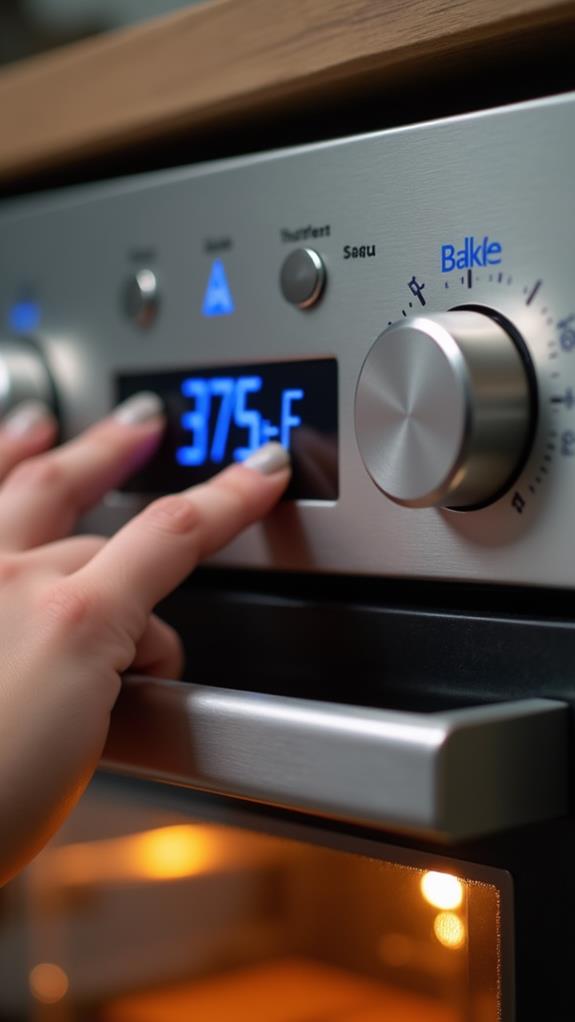
Before you begin assembling your meatball, sage, and squash lasagna, it's crucial to preheat your oven to 375°F (190°C). This step ensures that your oven reaches the optimal temperature for baking the lasagna evenly.
While your oven is heating up, you can start preparing the other ingredients and assembling the dish.
Don't be tempted to skip this step or rush the preheating process. A properly preheated oven is essential for achieving the perfect texture and flavor in your lasagna. The high temperature will help cook the noodles, melt the cheese, and blend the flavors of the meatballs, sage, and squash.
If you're using a convection oven, you may need to adjust the temperature slightly. In this case, set your oven to 350°F (175°C) instead. The circulating air in a convection oven distributes heat more efficiently, so a lower temperature is often sufficient.
Step 2. Layer Sauce and Noodles
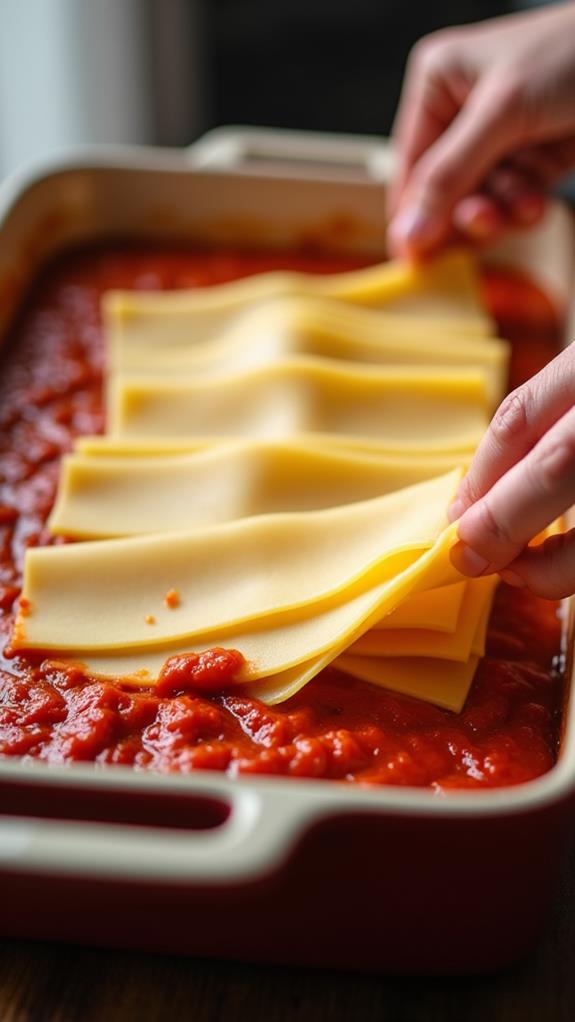
Starting with a thin layer of marinara sauce, you'll begin building your lasagna in a 9×13 inch baking dish. Spread the sauce evenly across the bottom, ensuring it covers every corner. This initial layer prevents the noodles from sticking and adds moisture to the dish.
Next, lay down your first layer of no-boil lasagna noodles. Don't worry if they don't fit perfectly; you can break them to cover the entire surface. Overlap the edges slightly to prevent gaps in your lasagna. Remember, these noodles will expand as they cook, so it's okay if there are small spaces between them.
Now, you're ready to add your meatballs. Slice them thinly and distribute them evenly over the noodles. Follow this with a layer of butternut squash puree, spreading it gently to create a smooth surface. Sprinkle chopped sage leaves over the squash for an aromatic touch.
Repeat these layers, alternating noodles, meatballs, squash, and sage until you've used all your ingredients. Finish with a final layer of noodles and top it off with the remaining marinara sauce.
Step 3. Layer Meatballs and Squash
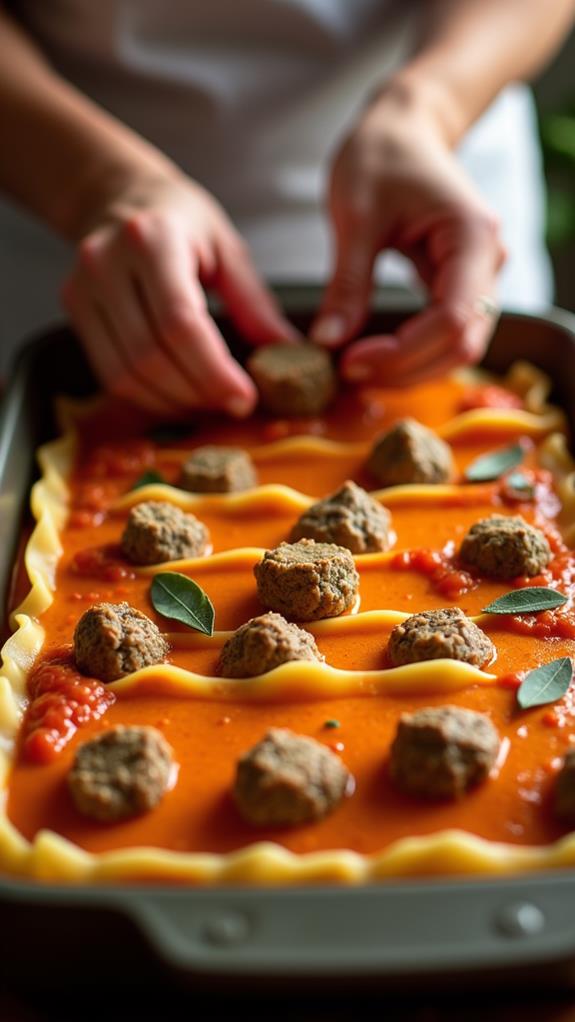
Layering the meatballs and squash is a crucial step in creating this unique lasagna. After you've spread the initial layer of marinara sauce and placed the first layer of noodles, it's time to add the meatballs. Slice the pre-made meatballs thinly and distribute them evenly across the noodles. This ensures that every bite will contain a savory morsel of meat.
Next, spoon the butternut squash puree over the meatballs, spreading it gently to create a uniform layer. The creamy texture of the squash will complement the heartiness of the meatballs perfectly. Sprinkle a portion of the chopped sage leaves over the squash layer. Remember, a little sage goes a long way, so use it sparingly.
Continue this layering process, alternating noodles, meatballs, squash, and sage until you've used all your ingredients. Be sure to press down gently on each layer to remove any air pockets, which could cause the lasagna to collapse during baking.
Your final layer should be noodles, topped with the remaining marinara sauce. This will create a beautifully golden, slightly crispy top when baked.
Step 4. Add Sage and Repeat Layers
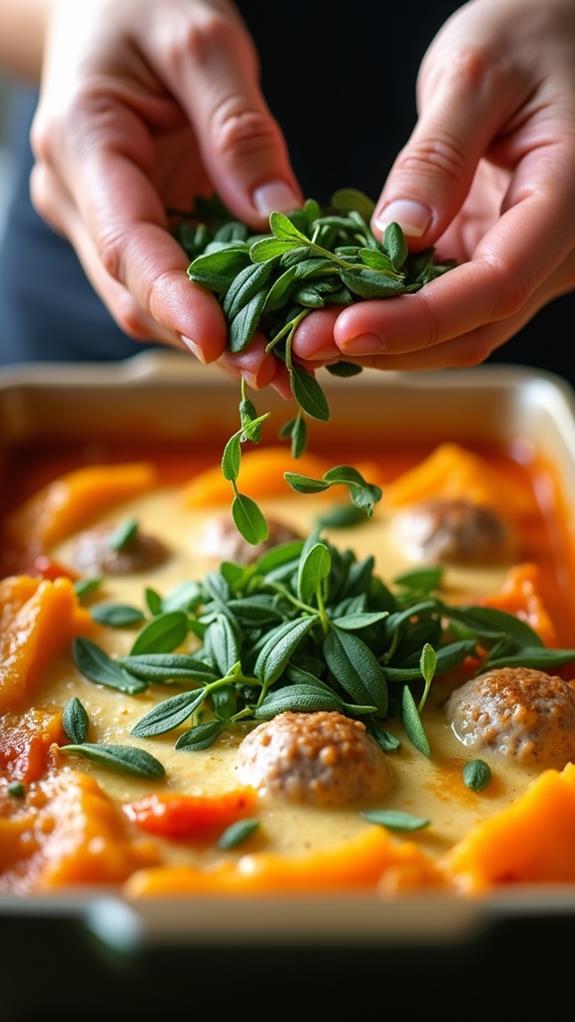
The aromatic sage leaves play a crucial role in this unique lasagna. After you've layered the meatballs and squash puree, it's time to add the sage. Sprinkle a generous amount of chopped fresh sage leaves over the squash layer, ensuring even distribution.
Don't be tempted to use dried sage, as fresh leaves provide a more vibrant flavor and aroma.
Now, you'll repeat the layering process. Place another layer of lasagna noodles on top of the sage, followed by more sliced meatballs, squash puree, and chopped sage. Continue this pattern until you've used all your ingredients, making sure to reserve some marinara sauce for the top layer.
As you build the layers, press down gently to remove any air pockets. This will help the lasagna hold together better when serving.
For the final layer, place lasagna noodles on top and cover them with the remaining marinara sauce. This will prevent the noodles from drying out during baking and create a deliciously crispy top layer.
Step 5. Bake Covered, Then Uncovered
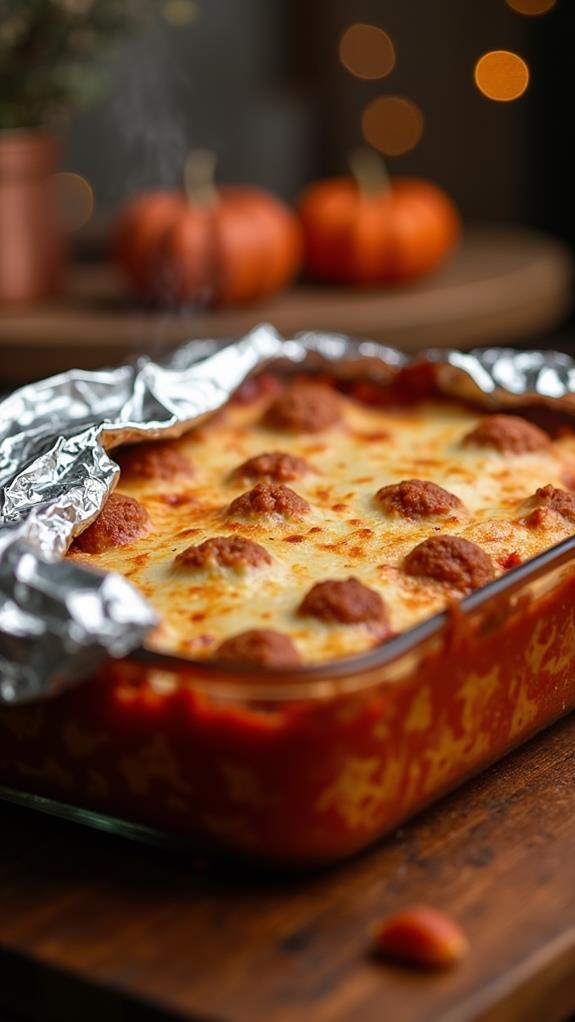
Once you've assembled all the layers, it's time to bake your lasagna. Start by preheating your oven to 375°F (190°C). Cover the baking dish tightly with aluminum foil, ensuring it's sealed well to trap moisture and heat. This initial covered baking period will help cook the noodles and meld the flavors together without drying out the top layer.
Place the covered dish in the preheated oven and bake for 30 minutes. During this time, the heat will penetrate through the layers, cooking the noodles and warming the ingredients.
After 30 minutes, carefully remove the foil. Be cautious, as hot steam will escape. Now, return the uncovered lasagna to the oven for an additional 15 minutes. This final uncovered baking allows the top to become golden and slightly crispy, creating a delicious contrast to the softer layers beneath.
You'll know it's ready when the edges are bubbling and the top has a beautiful golden-brown color. Once done, remove from the oven and let it rest for 10 minutes before serving. This resting period allows the lasagna to set, making it easier to cut and serve.
Final Thoughts
In conclusion, this meatball, sage, and squash lasagna offers a delightful twist on a classic dish. You'll find that the combination of savory meatballs, aromatic sage, and sweet squash creates a unique flavor profile that's both comforting and exciting.
By using pre-made meatballs and no-boil noodles, you've simplified the cooking process without sacrificing taste.
Remember, the key to success lies in the quality of your ingredients. Don't hesitate to splurge on high-quality meatballs or take the time to make your own. If you're feeling adventurous, try roasting and pureeing fresh butternut squash for an even richer flavor.
Be cautious with the sage, as a little goes a long way.
This lasagna is perfect for fall and winter gatherings, offering a hearty meal that's sure to impress your guests. It's also a great make-ahead dish, as the flavors will continue to meld and improve overnight.
Serve it with a simple green salad and crusty bread for a complete meal that celebrates the season's best flavors.

